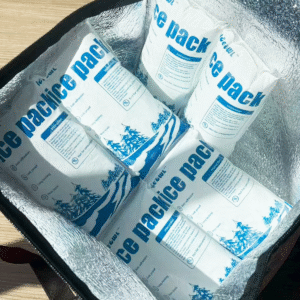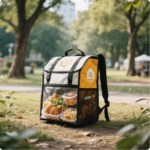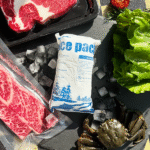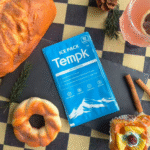Introduction: Si vous demandez comment emballer avec de la glace sèche pour l'expédition, Voici la réponse courte: Produits avant la référence, Utilisez un expéditeur isolé ventilé, entourer la charge utile de neige carbonique, et Mark Et1845 avec des kilogrammes nets et un Classe 9 étiqueter pour l'air. Planifier grossièrement 5–10 lb par 24 heures plus un tampon pour surmonter les retards.
-
Une taille de glace carbonique adaptée à votre piste, avec un 5–10 lb par jour estimateur (en quart de travail: quantité de glace carbonique par 24 heures)
-
Étiquetage et documents: Et1845, Kg net, Classe 9, et texte AWB pour l'air (en quart de travail: Voici pi 954 liste de contrôle)
-
Des choix d’emballage qui réduisent les allégations de décongélation (en quart de travail: Expéditeur VIP ou isolé en mousse)
-
Conseils aux opérateurs qui améliorent l’acceptation et réduisent les retours (en quart de travail: glace sèche d'emballage ventilé)
Comment emballer avec de la neige carbonique pour l'expédition, étape par étape?
Réponse directe: Précongeler à 0 °F (–18 ° C), utiliser une boîte extérieure rigide avec une doublure EPS/PU/VIP, Gardez les évents ouverts, placez de la glace carbonique autour (pas seulement sous) la charge utile, et marquez « Glace carbonique/dioxyde de carbone, solide,»Et1845, et net kg; ajouter une classe 9 pour l'air. Pesez entre 5 et 10 lb par jour de transit et ajoutez une réserve de 24 heures.
Pourquoi ça marche: La neige carbonique devient du gaz CO₂; votre emballage doit être ventilé pour éviter l'accumulation de pression. Les expéditions aériennes suivent Voici pi954 (emballage ventilé, Entrées AWB, ≤ 200 kg / package, Classe 9). Sol (NOUS.) nécessite toujours le nom propre UN1845 et Kg net sur le carton, et l'emballage doit libérer du gaz. Les transporteurs s'alignent souvent sur l'IATA pour une acceptation plus fluide.
Quelle quantité de neige carbonique par jour pour les envois congelés?
Prévoyez 5 à 10 lb par 24 heures dans un expéditeur bien isolé, puis ajoutez de la marge pour la chaleur et les retards. Meilleure isolation (PSE épais, Pur, ou vip) réduit les brûlures quotidiennes; des charges plus complètes réduisent les poches d'air chaud. Convertir en kilogrammes pour les étiquettes (kg = livre × 0.4536).
| Aperçu du dimensionnement | Base de base (kg) | Avec tampon (kg) | Ce que cela signifie pour vous |
|---|---|---|---|
| 24 h, PSE standard | ~8 | ~10 | Risque du week-end? Arrondir à 12 kg. |
| 48 h, PSE épais | ~16 | ~20 | Moins de points chauds; températures plus stables. |
| 72 h, VIP | ~22 | ~26 | VIP réduit la masse totale de glace. |
Conseils pratiques et gains rapides
-
Itinéraire chaud de deux jours: Mise à niveau vers 1,5–2 en isolation ou VIP; puis ajouter 20% glace carbonique supplémentaire.
-
Contact alimentaire: Utilisez une barrière pour que la glace ne touche jamais directement les aliments; évitez les sacs en plastique scellés pour la neige carbonique.
-
Placement: « Sandwich » à la charge utile : blocs de base + côtés + granulés supérieurs – pour éliminer les poches chaudes.
Cas réel: Une marque de pâtisserie DTC est passée des pellets uniquement aux blocs à la base plus des pellets sur les côtés/dessus et a ajouté un 20% tampon d'été; les « livraisons douces » ont chuté 38% et les arrivées temporaires ont bondi.
Comment emballer avec de la neige carbonique pour l'expédition: étiquettes & documents?
Réponse directe: Marque «Dioxyde de glace sèche / carbone, solide,»Et1845, masse nette de glace carbonique en kilogrammes, et appliquer le Classe9 étiqueter pour l'air. Sur la facture des transports aériens, ajoutez: «Un1845, Glace sèche, n × kg. » Voici les bouchons Pi954 200 kg / package et nécessite un emballage ventilé.
Conseils élargis: NOUS. sol (HMR/PHMSA) nécessite toujours un nom propre, Et1845, Kg net, et ventilation; une classe 9 l’étiquette n’est pas mandatée par l’HMR, bien que les transporteurs puissent s'harmoniser avec l'IATA. Les outils de travail FedEx spécifient également les tailles de caractères minimales lisibles et la classe 100 × 100 mm. 9 diamants; apposer des étiquettes sur la boîte extérieure, pas à l'intérieur des manches.
Modèles prêts à copier (gardez votre SOP)
-
Texte AWB:
UN 1845, Dry Ice, __ packages × __ kg -
Marques de carton (air): Nom propre, Et1845, Kg net, Classe 9; Adresses expédiées / destinataire.
-
Marques de carton (NOUS. sol): Nom propre, Et1845, Kg net; emballage ventilé (pas de systèmes hermétiques).
Quel emballage vous aide à emballer avec de la neige carbonique pour une expédition efficace?
Réponse directe: Utilisez un extérieur ondulé rigide avec un insert isolé (EPS/PUR pour 24–72 h; VIP pour les voies plus longues ou plus risquées). Ne rendez jamais le système étanche à l'air, le CO₂ doit s'échapper.
Étendu: L’EPS est rentable pendant 1 à 2 jours; EPS/PUR plus épais prolonge le temps de maintien; VIP atteint des performances sur plusieurs jours avec moins de réfrigérant et de poids, réduisant les réclamations et les frais volumétriques – idéal pour les lignes internationales ou directes.
VIP vs mousse: quand la « prime » est-elle remboursée?
Détails: Les systèmes VIP offrent 96–240+ heures performances avec une masse de glace carbonique inférieure. Si vos voies sont confrontées à des retards ou si la charge utile est de grande valeur, VIP réduit souvent le coût total au débarquement grâce à des économies de poids et à moins de réexpéditions.
| Conditionnement | Épaisseur typique | Durée typique | Ce que cela signifie pour vous |
|---|---|---|---|
| PSE (mousse) | 1–1,5 po | 24–48 h | Le moins cher; ajouter du tampon en chaleur. |
| PSE épais / Pur | 1.5–2 pouces | 48–72 h | Détenir plus; moins de masse de glace. |
| Panneaux VIP | 0.4–0,8 po | 96–240 heures | Murs les plus fins; meilleure stabilité. |
Comment emballer avec de la neige carbonique pour l'expédition entre transporteurs?
Réponse directe: Pour FedEx/UPS aérien, suivre Voici pi954 (emballage ventilé, Et1845, Classe 9, Texte AWB). USPS permet ≤5 livres glace carbonique dans le courrier aérien intérieur avec des règles d'emballage spécifiques; Le courrier international avec de la glace sec est interdit.
Étendu: Attendez-vous à des contrôles d’acceptation aux guichets. Obtenir le texte AWB et Kg net acceptation parfaite des vitesses. De nombreux intégrateurs harmonisent la manutention au sol avec la norme aérienne pour réduire les erreurs.
Conformité à la chaîne du froid au-delà de la façon d'emballer avec de la neige carbonique pour l'expédition
Réponse directe: Documentez vos contrôles de température, personnel de formation, et conserver les dossiers pour satisfaire aux exigences de la FSMA en matière de transport sanitaire. Définir les cibles d'arrivée (Par exemple, 0 ° F pour les aliments surgelés), logique de dimensionnement, et vérification (enregistreurs de données ou contrôles d'arrivée).
Liste de contrôle simple: Procédures; entraînement (EPP, ventilation, étiquetage); enregistrements (plans de voies, fichiers d'enregistrement, actions correctives). Intégrez cela dans vos SOP et vos audits.
2025 évolutions et tendances dans le transport de glace carbonique
Aperçu de la tendance: Les transporteurs ont renforcé leur acceptation des listes de contrôle PI954 (Par exemple, explicite 200 kg/emballage et ventilation). Publication mise à jour par USPS 52 dans 2025; Les produits VIP et réutilisables se multiplient pour réduire le poids et les réclamations des réfrigérants. Attendez-vous à une contre-acceptation plus rapide lorsque les étiquettes et les entrées AWB sont exactes.
Dernier progrès en un coup d'œil
-
L’adoption des VIP s’accélère: Des temps de maintien plus longs avec moins de glace réduisent les coûts et les dommages.
-
Les programmes réutilisables se développent: Moins de déchets et profils thermiques stables pour les voies récurrentes.
-
La clarté des aides à l’emploi s’améliore: Tailles des étiquettes, hauteurs de texte, et "pas de sacs scellés" crié clairement.
Perspicacité du marché: La demande d’emballages pour la chaîne du froid continue de croître avec les aliments surgelés et les produits biologiques DTC. La mise à niveau vers des doublures plus épaisses ou VIP ainsi qu'un dimensionnement plus intelligent réduit généralement les remboursements et les réexpéditions – un retour sur investissement que de nombreux expéditeurs mesurent désormais en semaines., pas de quartiers.
FAQ
Q1: Ai-je besoin d'une déclaration de l'expéditeur si la glace sèche est la seule DG?
Généralement Non lorsque le contenu n'est pas DG; vous avez toujours besoin du UN1845, Kg net, Classe 9 (air), et corriger le texte AWB. Vérifier les variations de l'opérateur.
Q2: Quelle quantité de neige carbonique dois-je prévoir par jour?
Commencer par 5–10 lb par 24 heures, puis ajoutez un tampon de 24 heures pour les retards; une meilleure isolation réduit la quantité.
Q3: Quelle taille la classe doit-elle 9 l'étiquette soit?
Minimum 100 × 100 mm; gardez les bordures claires et n'écrivez pas à l'intérieur du diamant.
Q4: Tous les pièges spécifiques à l'opérateur?
Air USPS casquettes à ≤5 livres par envoi postal et interdit le courrier international sur glace carbonique. FedEx/UPS appliquent les détails d'acceptation du PI954 aux comptoirs.
Q5: Quelles erreurs provoquent des retards?
Des colis hermétiques, manquant Kg net, marquer les livres au lieu des kilogrammes, isolation mince, et sauter la couverture supérieure/latérale.
Résumé & recommandations
Souviens-toi: Comment emballer avec de la neige carbonique pour l'expédition se résume à un emballage isotherme ventilé, couverture latérale/supérieure, et correct Et1845 + Kg net marquage (Classe 9 pour l'air). Plan 5–10 lb / jour plus tampon; améliorer l'isolation des voies chaudes ou longues; et gardez la documentation FSMA bien rangée.
Étapes suivantes: Cartographiez votre semaine la plus chaude et vos heures de transit; choisissez EPS/PUR ≥1,5 po ou VIP; calculer la glace avec l'estimateur; imprimez vos modèles AWB/carton; faire un test avec un enregistreur; intégrer les SOP à l'échelle du site. CTA: Démarrez dès aujourd'hui une conception d'emballage spécifique à une voie avec Tempk.
À propos du tempk
Nous concevons des emballages à température contrôlée – EPS, Pur, et systèmes VIP validés pour PI954, qui équilibrent conformité et coût. Notre science de l'emballage, bûcherons de données, et les dimensions adaptées aux voies vous aident à expédier des produits plus froids avec moins de poids, réduire les réclamations, et accélérer l'acceptation des compagnies aériennes. Les clients constatent régulièrement moins de réexpéditions et un dédouanement plus rapide après le déploiement de nos SOP. Concevons votre prochain emballage.
























